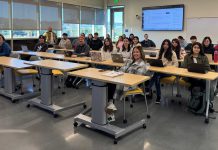Gilroy
– As judges of the Gilroy High School speech debate tallied
their final marks, principal Bob Bravo entertained a few questions
from the Gilroy Rotarians who sponsored the speech contest Tuesday
afternoon at the Gilroy Elks Lodge.
Gilroy – As judges of the Gilroy High School speech debate tallied their final marks, principal Bob Bravo entertained a few questions from the Gilroy Rotarians who sponsored the speech contest Tuesday afternoon at the Gilroy Elks Lodge.
Perhaps the most relevant question dealt with the amount of work teachers are expected to complete on a daily basis. Earlier this month, the Gilroy Teachers Association filed an unfair labor claim against the school district, claiming teachers were required to do too much work without compensation.
“More and more, the pressure of accountability has come to bear,” Bravo said, referring to the state’s decision in 1999 to hold schools accountable largely according to standardized test scores.
Bravo said he doesn’t view the issue of the unfair labor claim as a good guys versus bad guys scenario, but rather as an opportunity for parents, administrators and teachers to work together.
Specifically, Bravo spoke about Edline, a new communication tool unveiled at the high school this year to facilitate communication among parents, teachers and students.
Although some parents are frustrated teachers haven’t yet jumped on board, Bravo said patience will be necessary as teachers undergo the training.
Other questions Rotarians asked involved the idea of introducing biotechnology classes to the high school, as well as an update on the number of fights on campus.
Implementing biotechnology classes is a prospect Bravo said is possible, but will need further research and funding. Although there is no class dedicated solely to biotechnology, Bravo said some biology classes are starting to integrate biotechnology material, and more than half of the high school’s science teachers have gone through training in that area.
If the high school were to create a biotechnology class, Bravo said he would want students to have access to labs and equipment, which are expensive. One possibility the school is considering is converting current lab space into a biotech lab, as opposed to building an entirely new lab.
Another question addressed the number of students involved in fights at the high school, which has seen a cyclical pattern over the past few years. In 2002-03, Bravo said 3 percent of the school’s population – or about 75 students – were involved in fights, drawing on data from the beginning of the year through February. The next year it decreased to 2.3 percent, and this year it jumped to 3.3 percent.
The leading cause of fights by far, Bravo said, are disputes involving boyfriends and girlfriends, such as when a boy sees another boy talking to his girlfriend or when a girl sees another girl talking to her boyfriend, and becomes defensive. Less than 25 percent of fights on campus involve gang colors, Bravo said, and only about 2 percent of the student body has received warnings for constantly wearing gang colors.













